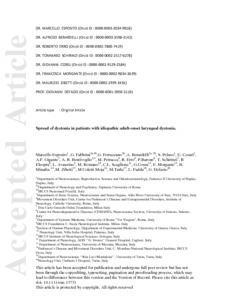Esposito, M;
Fabbrini, G;
Ferrazzano, G;
Berardelli, A;
Peluso, S;
Cesari, U;
Gigante, AF;
Bentivoglio, AR;
Petracca, M;
Erro, R;
et al.
Esposito, M; Fabbrini, G; Ferrazzano, G; Berardelli, A; Peluso, S; Cesari, U; Gigante, AF; Bentivoglio, AR; Petracca, M; Erro, R; Barone, P; Schirinzi, T; Eleopra, R; Avanzino, L; Romano, M; Scaglione, CL; Cossu, G; Morgante, F; Minafra, B; Zibetti, M; Coletti Moja, M; Turla, M; Fadda, L; Defazio, G
(2018)
Spread of dystonia in patients with idiopathic adult-onset laryngeal dystonia.
Eur J Neurol, 25 (11).
pp. 1341-1344.
ISSN 1468-1331
https://doi.org/10.1111/ene.13731
SGUL Authors: Morgante, Francesca
![[img]](https://openaccess.sgul.ac.uk/110644/1.hassmallThumbnailVersion/esposito2018.pdf)  Preview |
|
PDF
Accepted Version
Available under License ["licenses_description_publisher" not defined].
Download (104kB)
| Preview
|
Abstract
BACKGROUND AND PURPOSE: Adult-onset laryngeal dystonia (LD) can be isolated or can be associated with dystonia in other body parts. Combined forms can be segmental at the onset or can result from dystonia spread to or from the larynx. The aim of this study was to identify the main clinical and demographic features of adult-onset idiopathic LD in an Italian population with special focus on dystonia spread. METHODS: Data were obtained from the Italian Dystonia Registry (IDR) produced by 37 Italian institutions. Clinical and demographic data of 71 patients with idiopathic adult-onset LD were extracted from a pool of 1131 subjects included in the IDR. RESULTS: Fifty of 71 patients presented a laryngeal focal onset; the remaining subjects had onset in other body regions and later laryngeal spread. The two groups did not show significant differences of demographic features. 32% of patients with laryngeal onset reported spread to contiguous body regions afterwards and in most cases (12 of 16 subjects) dystonia started to spread within 1 year from the onset. LD patients who remained focal and those who had dystonia spread did not show other differences. CONCLUSIONS: Data from IDR show that dystonic patients with focal laryngeal onset will present spread in almost one-third of cases. Spread from the larynx occurs early and is directed to contiguous body regions showing similarities with clinical progression of blepharospasm. This study gives a new accurate description of LD phenomenology that may contribute to improving the comprehension of dystonia pathophysiology.
| Item Type: |
Article
|
| Additional Information: |
This is the peer reviewed version of the following article: Esposito, M. , Fabbrini, G. , Ferrazzano, G. , Berardelli, A. , Peluso, S. , Cesari, U. , Gigante, A. F., Bentivoglio, A. R., Petracca, M. , Erro, R. , Barone, P. , Schirinzi, T. , Eleopra, R. , Avanzino, L. , Romano, M. , Scaglione, C. L., Cossu, G. , Morgante, F. , Minafra, B. , Zibetti, M. , Coletti Moja, M. , Turla, M. , Fadda, L. and Defazio, G. (2018), Spread of dystonia in patients with idiopathic adult‐onset laryngeal dystonia. Eur J Neurol, 25: 1341-1344, which has been published in final form at https://doi.org/10.1111/ene.13731. This article may be used for non-commercial purposes in accordance with Wiley Terms and Conditions for Use of Self-Archived Versions. |
| Keywords: |
adult focal dystonia, laryngeal dystonia, spread, 1103 Clinical Sciences, 1109 Neurosciences, Neurology & Neurosurgery |
| SGUL Research Institute / Research Centre: |
Academic Structure > Molecular and Clinical Sciences Research Institute (MCS) |
| Journal or Publication Title: |
Eur J Neurol |
| ISSN: |
1468-1331 |
| Language: |
eng |
| Dates: |
| Date | Event |
|---|
| 10 October 2018 | Published | | 31 July 2018 | Published Online | | 19 June 2018 | Accepted |
|
| Publisher License: |
Publisher's own licence |
| PubMed ID: |
29935029 |
 |
Go to PubMed abstract |
| URI: |
https://openaccess.sgul.ac.uk/id/eprint/110644 |
| Publisher's version: |
https://doi.org/10.1111/ene.13731 |
Statistics
Item downloaded times since 11 Feb 2019.
Actions (login required)
 |
Edit Item |



